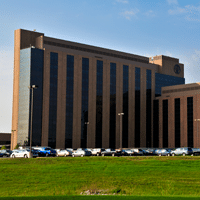A wise institution allows its legacy to inform its future, and St. Joseph Mercy Hospital Ann Arbor has a history of environmentally conscious practices, especially regarding energy. This history was crucial as it planned to upgrade its buildings.
The hospital moved to it current campus in Ann Arbor, Michigan, in 1977, and after 25 years much of the infrastructure had ceased to be efficient. In 2004, as St. Joseph Mercy Ann Arbor considered its construction and renovation needs, it instituted an aggressive and comprehensive energy-management program; Tom Tocco, vice president for support services and capital projects, led the way. “I hired some in-house expertise, a certified energy manager named Paul Dobry, and got the entire engineering department and caregiving staff energized toward our goal, which was to dramatically reduce our energy consumption,” Tocco says.
St. Joseph Mercy Ann Arbor also brought a together a team of subcontractors and consultants, led by Dobry, who ultimately decided what should be done on campus. Improving the Energy Center was the first step. The power from this building is distributed throughout the 340-acre, three-million-square-foot campus. “Given the magnitude of that distribution, we addressed all the energy opportunities including upgrades to the center’s three major boilers and chilled-water-distribution systems to get the biggest bang for our buck,” Tocco says. The improvements to the Energy Center were done in part by mechanical contractor John E. Green Company and electrical contractor A.F. Smith Electric.
In 2007, St. Joseph Mercy Ann Arbor tackled the first of its two patient towers. The cost to renovate versus build new was nearly identical, so the hospital chose to tear down the old structures and start fresh. The east tower’s natural gas use was reduced via changes made in the Energy Center, other green components helped reduce water use and energy consumption via lighting controls.
The water systems that support domestic use, as well as water used for heating and cooling, are all fed through complex, energy-efficient pumping systems. The pumping system reacts when water is demanded; because this is variable, it decreases the amount of required energy to move water. The same is true for the pumping systems that support the heating, cooling, and ventilation systems.
The heating, ventilation, and air-conditioning systems’ variable speed technology allows them to increase or decrease based on occupant needs. “We also harvest the light that comes in from the sun,” Tocco says. “During the daylight hours, our control systems are elaborate enough to sense the light and shut off automatically.” Similar technologies were incorporated into the north patient tower in 2010.
In spring 2012, St. Joseph Mercy Ann Arbor finished the renovation of its chapel and main entrance to complete its $300 million master plan. Upgrades throughout include efficient HVAC systems that allow new operating rooms to conserve energy. Air in operating rooms needs to move at rapid rates to control infection; typically, a room might be exchanging air up to 30 times every hour, which is expensive and inefficient, but necessary at certain times. St. Joseph Mercy Ann Arbor, however, reduced energy use by installing occupancy controls. “Now, if the doctor or patient are not in the room, the air isn’t moving at 30 exchanges per hour,” Tocco says. “It is moving at a code-minimum 15 exchanges rate.”
The payback from the energy-saving initiatives has been astonishing, Tocco says. The healthcare system’s purchase of energy decreased dramatically as it went from spending $10 million on energy to $7.5 million today. “Since 2004, we’ve had a net increase of 500,000 square feet … on our campus, if you take into account what we tore down and what we put up,” Tocco says. “During that period of time, our natural gas usage is down 21 percent, our electricity is down 12 percent, and water and sewer is down 58 percent. Those results speak for themselves.”
The work continues as St. Joseph Mercy Ann Arbor pushes to further reduce its energy use with electrical and lighting control improvements. The organization also is in the process of creating a new master plan, which will take the healthcare system through the year 2022. New areas of attention include an outpatient surgery pavilion, cancer service facilities, and the enhancement of physician partnerships and physical practice development. Tocco says future infrastructure will benefit from the same green initiatives and energy-saving features its recently built facilities received.
The Ann Arbor facility also is just one of Trinity Health’s 48 hospitals. Over the next several years, Trinity intends to leverage expertise in energy reduction by working with St. Joseph Mercy Ann Arbor and other member hospital systems to reduce its energy dependency. “Our hope is that we can provide access to this knowledge and capability nationwide, throughout the Trinity system, as we are actively heading down this path,” Tocco says. “We’ve been as generous as possible, conducting tours and providing access to what we’ve been doing through speaking engagements and sharing the technologies that have worked for us. We actively share this information with all healthcare organizations. Mr. Dobry’s favorite quote is ‘Knowledge not shared is knowledge wasted.’ That says it all.”


